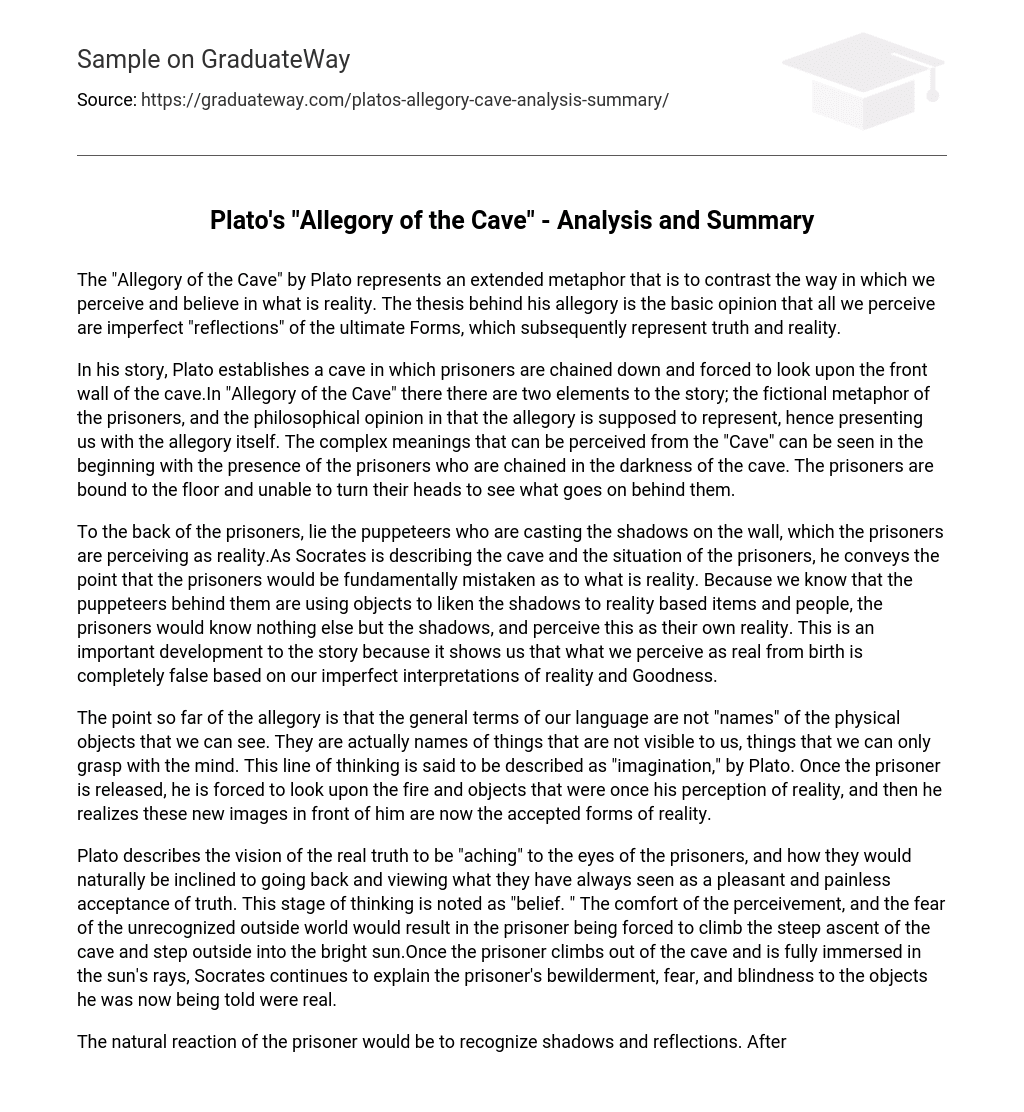The “Allegory of the Cave” by Plato represents an extended metaphor that is to contrast the way in which we perceive and believe in what is reality. The thesis behind his allegory is the basic opinion that all we perceive are imperfect “reflections” of the ultimate Forms, which subsequently represent truth and reality.
In his story, Plato establishes a cave in which prisoners are chained down and forced to look upon the front wall of the cave.In “Allegory of the Cave” there there are two elements to the story; the fictional metaphor of the prisoners, and the philosophical opinion in that the allegory is supposed to represent, hence presenting us with the allegory itself. The complex meanings that can be perceived from the “Cave” can be seen in the beginning with the presence of the prisoners who are chained in the darkness of the cave. The prisoners are bound to the floor and unable to turn their heads to see what goes on behind them.
To the back of the prisoners, lie the puppeteers who are casting the shadows on the wall, which the prisoners are perceiving as reality.As Socrates is describing the cave and the situation of the prisoners, he conveys the point that the prisoners would be fundamentally mistaken as to what is reality. Because we know that the puppeteers behind them are using objects to liken the shadows to reality based items and people, the prisoners would know nothing else but the shadows, and perceive this as their own reality. This is an important development to the story because it shows us that what we perceive as real from birth is completely false based on our imperfect interpretations of reality and Goodness.
The point so far of the allegory is that the general terms of our language are not “names” of the physical objects that we can see. They are actually names of things that are not visible to us, things that we can only grasp with the mind. This line of thinking is said to be described as “imagination,” by Plato. Once the prisoner is released, he is forced to look upon the fire and objects that were once his perception of reality, and then he realizes these new images in front of him are now the accepted forms of reality.
Plato describes the vision of the real truth to be “aching” to the eyes of the prisoners, and how they would naturally be inclined to going back and viewing what they have always seen as a pleasant and painless acceptance of truth. This stage of thinking is noted as “belief. ” The comfort of the perceivement, and the fear of the unrecognized outside world would result in the prisoner being forced to climb the steep ascent of the cave and step outside into the bright sun.Once the prisoner climbs out of the cave and is fully immersed in the sun’s rays, Socrates continues to explain the prisoner’s bewilderment, fear, and blindness to the objects he was now being told were real.
The natural reaction of the prisoner would be to recognize shadows and reflections. After his eyes adjust to the sunlight, he begins to see items and people in their own existence, outside of the cave.When the prisoner looks up to the sky and looks into the Sun, and recognizes it as the cause of all that is around him? ‘–he has perceived the “Form of the Good! This point in the passage marks the climax, as the prisoner, who not long ago was blind to the “Form of the Good” (as well as the basic Forms in general), now is aware of reality and truth. When this has occurred, the ultimate stage of thought has been achieved, and that is “understanding.
” Upon returning to the Cave, the prisoner would metaphorically (and literally) be entering a world of darkness yet again, and would be faced with the other unreleased prisoners. The other prisoners laugh at the released prisoner, and ridicule him for taking the useless rise out of the cave in the first place.The others cannot understand something they have yet to experience, so it’s up to this prisoner to represent leadership, for he alone is conscious of goodness. Plato, at this point describes the philosopher kings who have recognized the Forms of Goodness as having a duty to be responsible leaders and to not feel contempt for those whom don’t share his enlightenment.
The Allegory doesn’t solely represent our own misconceptions of reality, but also Plato’s vision of what a solid leader should be.The prisoner is expected to return to the cave and live amongst his former prisoners as someone whom can see better than all the rest, someone whom is now able to govern from truth and goodness. He is expected to care for his fellow citizens, “‘..
. you have been better and more thoroughly educated than those others and hence you are more capable of playing your part both as men of thought and as men of action. ” Upon realizing the Forms of Goodness, one assumes the responsibility of a qualified leader, and this presents the basis for Plato’s arguments for what composes just leadership and a just society.The “Allegory of the Cave” represents a complex model as to which we are to travel through our lives and understanding.
The four stages of thought combined with the progress of human development represent our own path to complete awareness in which the most virtuous and distinguished will reach, and upon doing so shall lead the public. The story as told by Socrates and Glaucon presents a unique look at the way in which reality plays such an important part in our own existence, and how one understands it can be used as a qualification for leadership and government.





